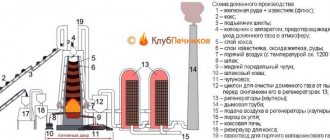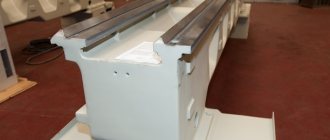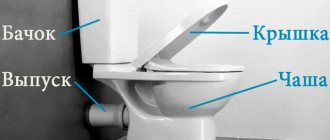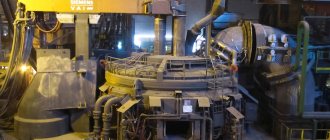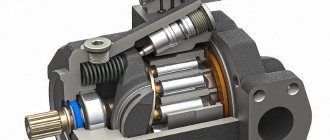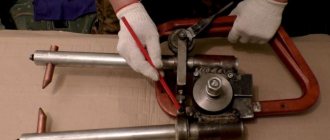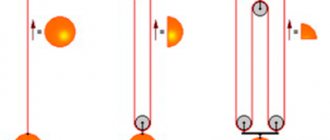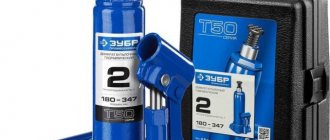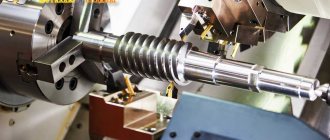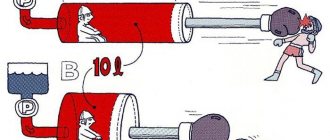Principle of operation
The operating principle of a blast furnace is as follows: ore charge with coke and limestone flux is loaded into the receiving chamber. In the lower part, periodic release of cast iron/ferroalloys and separately molten slag is carried out. Since the level of material in the blast furnace decreases during release, simultaneous loading of new batches of charge is required.
The operating process is constant, combustion is maintained with a controlled supply of oxygen, which ensures greater efficiency.
The design of the blast furnace ensures a continuous process of ore processing, the service life of the blast furnace is 100 years, major repairs are carried out every 3-12 years.
How does an open hearth furnace work?
Rice.
6 – Operating principle of an open hearth furnace The main operating principle of an open hearth furnace is based on the unique eutectic property of alloys. A hot mixture of air and flammable gas is blown into a furnace with a low ceiling, which reflects the heat downwards (Fig. 6). An open hearth furnace can be operated in several production modes, the determination of which will depend on the composition of the charge:
- Scrap process. In this case, the charge is based on 35-45% steel scrap (scrap). This production process will be relevant in factories where there is no possibility of installing blast furnaces, but there is a lot of scrap metal;
- Scrap ore process. In this process, the charge is based on liquid cast iron (about 75%), iron ore and scrap. It is considered the most popular process in factories where blast furnaces are installed.
Most open hearth furnaces are stationary. In the case of rocking furnaces, they have found their active use when working with phosphorous cast iron. This trend is due to the fact that phosphorus-enriched slag must be pumped.
The ignition process of swing-type furnaces is carried out using gaseous fuel or fuel oil. Generator or mixed gas, characterized by minimum combustion temperatures, is preheated in specialized generators before being supplied to the working chamber, the temperature in which can vary in the range from 1000 to 1100 degrees.
Photo of a blast furnace
Photo1
Photo 2
Photo 3
Photo4
Photo 5
Who invented it?
The modern blast furnace was invented by J.B. Neilson, who was the first to heat the air supplied to the blast furnace, which happened in 1829, and in 1857 E.A. Cowper introduced special regenerative air heaters into use.
This made it possible to significantly reduce coke consumption by more than a third and increase the efficiency of the furnace. Before this, the first blast furnaces were actually cheese-blowing furnaces, that is, unenriched and unheated air was blown into them.
The use of cowpers, that is, regenerative air heaters, made it possible not only to increase the efficiency of the blast furnace, but also to reduce or completely eliminate contamination, which was observed in case of technology violations. We can safely say that this invention made it possible to bring the process to perfection. Modern blast furnaces operate precisely on this principle, although their control today is automated and provides greater safety.
How does it work
To ensure continuity of work, a warehouse for pellets (sinter), flux and coke is installed near the blast furnace - a bunker designed for preparing the charge.
The supply of raw materials to the bunkers, as well as the supply of the charge to the filling devices at the top, is carried out in a continuous manner using conveyors.
Sinking under its mass, the charge enters the middle part of the furnace, where, under the influence of hot gases resulting from the combustion of coke, the iron ore material is heated, and the remaining gases exit through the top.
In the furnace, which is located at the bottom of the furnace, there are devices for supplying hot air flows under pressure - tuyeres. The tuyeres have windows with heat-resistant glass, allowing visual control of the process.
Please note: to protect against high temperatures, the devices are cooled with water through internal channels.
During the combustion process, coke and oxygen combine to form carbon dioxide.
The effect of high temperature on carbon dioxide converts the latter into carbon monoxide, which takes away the ore and reduces iron. The process of cast iron formation occurs after the iron passes through layers of hot coke. As a result of this process, iron is saturated with carbon.
After the cast iron has accumulated in the forge, the liquid metal is released through the holes located below - tapholes. First of all, slag is released through the upper tap hole, and then cast iron is released through the lower tap hole. Through special channels, the cast iron is poured into ladles placed on railway platforms and transported for further processing.
For the production of steel, cast iron is used, which is called conversion iron - it accounts for up to 80% of production.
Converting pig iron is transported to a steel foundry with converters, open-hearth furnaces or electric furnaces. In modern, huge blast furnaces, not only hot air flows are used to support combustion processes, but also pure oxygen, used together with natural gas.
This technology allows you to consume less coke, but is technologically more complex. Therefore, to control the production process and select optimal melting modes, computers are used that are capable of simultaneous analysis of the operation of all systems.
Watch an educational video that describes the operating principle and nuances of a blast furnace:
Domain process
Modern furnaces for melting cast iron provide approximately 80% of the total amount of cast iron; from the casting sites it is immediately supplied to electric smelting or open-hearth shops, where ferrous metal is converted into steel with the required qualities.
Pig iron is produced from cast iron, which is then sent to manufacturers for casting in cupola furnaces. To drain slag and cast iron, special holes called tapholes are used. However, in modern furnaces, not separate, but one common tap hole is used, divided by a special heat-resistant plate into channels for supplying cast iron and slag.
How does a blast furnace work?
The blast furnace process is entirely dependent on the excess carbon in the furnace cavity; it consists of thermochemical reactions occurring inside when all components are loaded and heated.
The temperature in a blast furnace can be 200-250°C directly under the top and up to 1850-2000°C in the active zone - steam.
When hot air is supplied to the furnace and coke is ignited, the temperature in the blast furnace rises, the process of decomposition of the flux begins, as a result of which the carbon dioxide content increases.
When the column of material in the charge decreases, iron monoxide is reduced; in the lower part of the column, pure iron is reduced from FeO, flowing into the furnace.
As the iron drains, it actively contacts carbon dioxide, saturating the metal and giving it the required properties. The total carbon content of iron can be as low as 1.7%.
Blast furnace structure
Iron production is an energy-intensive process that generates large amounts of heat. To understand what a blast furnace is, it is worth imagining a tall structure reaching 35 meters. The weight of a loaded blast furnace can be 30 thousand tons. Such a structure requires a solid foundation. It is laid in the form of a monolithic concrete foundation up to four meters high. In the place where the furnace hearth is planned to be located, the foundation is laid from refractory concrete. The entire furnace structure is supported by columns.
The furnace is located in the lower part of the structure; it bears the heaviest weight: smelted metal, slag and, in fact, the entire blast furnace. The furnace is unloaded through the forge, and hot air is supplied through it using special holes. This part of the blast furnace is subject to the highest requirements for materials of manufacture, tightness, fire resistance, and wear resistance.
Above the hearth there is a working surface in which the process of technological reduction of iron ore takes place, and even higher is the loading charge. This is a simplified, schematic description of the structure of a blast furnace; in fact, it is a complex high-tech structure with strictly defined functions. What is a blast furnace for? Primarily for iron smelting.
Blast furnace diagrams
Sectional diagrams of a blast furnace (different options):
Scheme 1
Scheme 2
Scheme 3
Scheme 4
Scheme 5
Supply of blast to the blast furnace
Blowing - Air supply by special blowing machines to industrial furnaces, furnaces, etc.
in order to speed up the processes taking place in them. Modern forced operation of powerful blast furnaces requires supplying them with blast with the appropriate pressure and temperature. The first two of these parameters are provided by blowers, and the last by the operation of air heaters.
A blast furnace heater (name options: air heater, regenerator, cowper) is a device for heating air (cold blast coming from a blower) before feeding it into a blast furnace. The introduction of air heaters has become the most effective way to save fuel (coke) in the entire history of blast furnace production.
Blast furnace device
The design of a blast furnace is very complex; it is a large complex that includes the following elements:
- hot blast zone;
- melting zone (this includes the hearth and shoulders);
- steam, that is, the zone where FeO reduction occurs;
- a mine where Fe2O3 reduction occurs;
- fire pit with pre-heating of the material;
- loading of charge and coke;
- blast furnace gas;
- the area where the material column is located;
- outlets for slag and liquid iron;
- collection for waste gases.
The height of a blast furnace can reach 40 m, weight – up to 35,000 tons, the capacity of the working area depends on the parameters of the complex.
The exact values depend on the load of the enterprise and its purpose, requirements for the volume of metal produced and other parameters.
A more detailed version of the device:
Blast furnace repair grades
To maintain the working condition of the blast furnace, major repairs are carried out regularly (every 3-15 years). It is divided into three types:
- The first category includes work on the production of melting products and inspection of equipment involved in the technological process.
- The second category is a complete replacement of equipment elements subject to medium repair work.
- The third category requires a complete replacement of the device, after which a new filling of raw materials is carried out with straightening of the tops.
Systems and equipment
A blast furnace is not only an installation for producing cast iron, but also numerous auxiliary components. This is a charge and coke supply system, removal of slag, molten iron and gases, an automatic control system, cowpers and much more.
The operating principles of the furnace remain the same as centuries ago, but modern computer systems and production automation have made the blast furnace more efficient and safer.
Cowpers
The modern design of a blast furnace involves the use of cowper to heat the supplied air. This is a cyclic installation made of heat-resistant material, which heats the nozzle up to 1200°C.
The cowper switches on the nozzle to 800-900°C when cooling, which ensures continuity of the process, reduces coke consumption and increases the overall efficiency of the design.
Previously, such a device was not used, but starting from the 19th century. it is necessarily part of the blast furnace.
The number of cowper batteries depends on the size of the complex, but usually there are at least three, which is done with the expectation of a possible accident and maintaining operability.
Top apparatus
The blast furnace apparatus - this part is the most responsible and important, including three gas seals operating according to an agreed scheme.
The operating cycle of this node looks like this:
- in the initial position the cone is raised, it blocks the exit, the lower cone is lowered;
- the skip loads the mixture into the furnace;
- the rotating funnel turns and passes the raw material through the windows onto a small cone;
- the funnel returns to its original position, closing the windows;
- the small cone is lowered, the load passes into the intercone space, after which the cone rises;
- the large cone takes its original position, releasing the charge into the cavity of the blast furnace for processing.
Skip
Skips are special charge lifters. With the help of such galosh lifts, raw materials are captured from the skip pit and conveyed upward along an inclined trestle.
Then the galoshes are tipped over, feeding the charge into the loading area, and returned down for a new portion. Today this process is carried out automatically; special computerized units are used for control.
Tuyeres and tapholes
The nozzle of the furnace lance is directed into its cavity, through which you can observe the progress of the smelting process. To do this, peepers with heat-resistant glass are mounted through special air ducts. At the cut, the pressure can reach 2.1-2.625 MPa.
Tapholes are used to drain cast iron and slag; immediately after release, they are tightly sealed with special clay. Previously, guns were used that were built with a plastic clay core; today, remote-controlled guns are used that can approach the structure closely. This solution made it possible to reduce the trauma and accident rate of the process and make it more reliable.
ABC of production
Blast smelting is the process of producing cast iron from iron ore processed in blast furnaces or, as they are also called, blast furnaces.
The main materials needed in the process of such production are:
- fuel in the form of coke obtained from coal;
- iron ore, which is the direct raw material for production;
- flux – special additives made from limestone, sand, and other materials.
Iron ore enters blast furnaces in the form of pieces of small rock fused together - agglomerates or pellets, in the form of ore lumps. The feedstock is loaded into the blast furnace top layer-by-layer, alternating with layers of coke and layer-by-layer addition of flux.
The slag that floats on the surface of the hot cast iron is drained before the metal hardens. The material loaded for cast iron smelting, consisting of iron ore, coke and flux, is called charge.
The blast furnace, which has a profile similar to a tower with a wide base, is lined inside with fireproof material - fireclay.
Construction of a blast furnace. (Click to enlarge)
The main design elements are:
- shoulders;
- steam;
- fire pit;
- mine
- horn
The steam chamber is the widest part of the blast furnace. It melts gangue ore and flux, resulting in slag. To prevent the impact of high temperatures on the masonry and furnace casing, refrigeration units with circulating water are used.
The blast furnace shaft is built in the shape of a cone that expands at the bottom - this design of the blast furnace allows the charge to fall freely during the smelting process. The formation of cast iron, which goes down into the furnace during the smelting process, occurs in steam and shoulders. To hold the solid charge in the steam and shaft, the shoulders have the shape of a cone, with an expansion towards the top.
How to make a blast furnace with your own hands?
Nuances
Cast iron production is a highly profitable business, but it is impossible to organize the production of ferrous metal without serious financial investments. Do-it-yourself blast furnace in “makeshift conditions” is simply not feasible, which is associated with many features:
- the extremely high cost of a blast furnace (only large plants can afford such expenses);
- the complexity of the design, despite the fact that a drawing of a blast furnace can be found in the public domain (above the diagram), it will not be possible to assemble a full-fledged unit for the production of cast iron;
- individuals and individual entrepreneurs cannot engage in the production of cast iron, simply no one will issue a license for this;
- deposits of raw materials for ferrous metallurgy are almost exhausted; there are no pellets or sinter on free sale.
But at home, you can assemble an imitation furnace (mini-blast furnace), with which you can melt metal.
But these works require maximum attention and are highly not recommended in the absence of experience. Why might it be necessary to make such a structure? Most often, this is heating for a greenhouse or cottage with the most efficiently used fuel.
Tools and materials
To make a structure at home, you need to prepare:
- metal barrel (can be replaced with a pipe with a larger diameter);
- two pieces of round pipe with a smaller diameter;
- channel section;
- Sheet steel;
- level, hacksaw, tape measure, hammer;
- inverter, set of electrodes;
- bricks, clay mortar (necessary for the foundation of the structure).
All work should be carried out only outside, since the process is quite dirty and requires free space.
Step-by-step instruction
- The top of the prepared barrel-shaped workpiece is cut off (it should be left, as it will be needed later).
- A circle with a diameter smaller than the diameter of the barrel is cut out of steel, and a hole is made in it for the pipe.
- The pipe is carefully welded to the circle, and sections of channel are welded at the bottom, which will press down the fuel during operation of the furnace.
- The furnace lid is made from the previously cut bottom of the barrel, in which a hole is made for a hatch with a door. It is also necessary to make a door through which the remaining ash will be removed.
- The stove must be installed on a foundation, as it gets very hot during operation. To do this, first a concrete slab is installed, then several rows of brick are laid out, forming a recess in the center.
- To remove combustion products, a chimney pipe is installed; the diameter of the straight part will be larger than the diameter of the stove body (required for better gas removal).
- The reflector is not a mandatory design element, but its use can increase the efficiency of the furnace.
Design Features
The features of such a self-made stove are:
- efficiency level is good;
- it is possible to work offline for up to 20 hours;
- In the furnace, there is not active combustion, but smoldering with constant heat release.
The main difference between a “household” blast furnace will be the restriction of air access to the combustion chamber, that is, smoldering of wood or coal will occur at a low level of oxygen. An industrial blast furnace works on a similar principle, but a household blast furnace is used only for heating; metal cannot be melted in it, although the temperature inside the chamber will be sufficient.
What is the domain process?
Blast furnace structure: 1. Hot blast.2. Melting zone (shoulders and hearth).3. FeO reduction zone (steam).4. Fe2O3 reduction zone (mine).5. Preheating zone (fire pit).6. Loading iron ore materials, limestone and coke.7. Blast furnace gas.8. Column of iron ore, limestone and coke.9. Slag release.10. Production of liquid cast iron.11. Collection of waste gases.
To successfully smelt pig iron in a blast furnace, the basic points must always be followed. First, the temperature throughout the furnace and heat must ensure that the required reactions occur in the right place and at the right time. This occurs due to the movement of two flows towards each other. Gas from fuel combustion rises from the bottom up, and the charge, heated by the heat of the gas, goes down from the top. Secondly, slag should be formed only when the reduction of iron and necessary impurities from the ore is completed
Here it is important to correctly select the refractoriness of the slag and the grade of cast iron. This is necessary to ensure that the slag does not prematurely fuse the ore, which will subsequently lead to a change in the composition of the cast iron and can cause a failure in the smelting process
The beginning of this process is the combustion of fuel. When interacting with oxygen, natural gas and coke carbon burn, generating significant heat.
C + O2 = CO2 + Q; CH4 + 2O2 = CO2 + 2H2O + Q
The combustion products interact with coke in accordance with the reactions:
CO2 + C = 2CO – Q; H2O + C = CO + H2 – Q
In this mixture, carbon monoxide is the main reducing agent of iron from iron oxides. To increase furnace productivity, the air entering the furnace is humidified, thereby increasing the amount of reducing agent. When raised, the gases, whose temperature is quite high, heat the charge. At the same time, they themselves cool to approximately 300-400 degrees. The charge moves down towards the gas. When the temperature reaches approximately 570°C, reduction of iron oxides occurs. This process consists of several successive stages according to the scheme: Fe2O3 -> Fe3O4 -> FeO -> Fe.
https://youtube.com/watch?v=0KagREkazW4
Temperature determines these chemical reactions. The reduction of iron oxide occurs with solid carbon (direct reduction), hydrogen and carbon monoxide (indirect reduction). In the first case, the process is carried out in the steam zone in the presence of high temperatures in accordance with the reaction: FeO + C = Fe + CO – Q.
In the second case, with indirect reduction, the reaction occurs at a lower temperature in the upper part of the furnace: 3Fe2O3 + CO = 2Fe3O4 + CO2 + Q; Fe3O4 + CO = 3Fe O + CO2 – Q; Fe O + CO = Fe + CO2 + Q.
Cost using the example of efficiency factor No. 7
Manufacturing blast furnaces is a resource-intensive and expensive process that cannot be put into production. Since blast furnaces are used exclusively in industry, their design and assembly are carried out for a specific metallurgical complex, which includes many objects and components of the internal infrastructure. This situation is observed not only in the Russian Federation, but also in other countries of the world that have their own metallurgy facilities.
The cost of manufacturing and installing a blast furnace is quite high, which is associated with the complexity of the work. An example is the large domain complex No. 7 called “Rossiyanka”, installed in 2011. Its cost was 43 billion rubles; the best engineers from Russia and foreign countries were involved in production.
The complex includes the following units:
- ore receiving device;
- inlet stations of the bunker overpass and the central hub;
- bunker overpass;
- compressor station (installed at the foundry yard);
- installation for injection of pulverized coal fuel;
- utilization thermal power plant;
- control center and administrative building;
- foundry yard;
- blast furnace;
- air heating blocks;
- pumping station.
Complex performance:
The new complex ensures the production of more than 9,450 tons of cast iron per day, the useful volume of the furnace is 490 cubic meters, and the working volume is 3,650 cubic meters. The design of the blast furnace ensures waste-free and environmentally friendly production of cast iron; blast furnace gas for thermal power plants and slag used in road construction are obtained as by-products.
